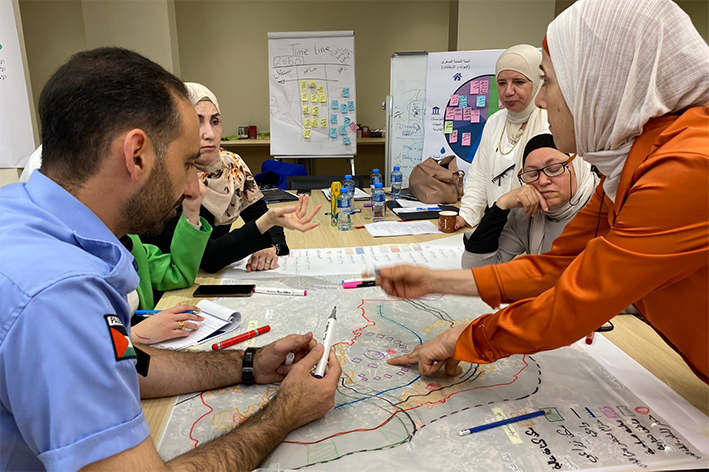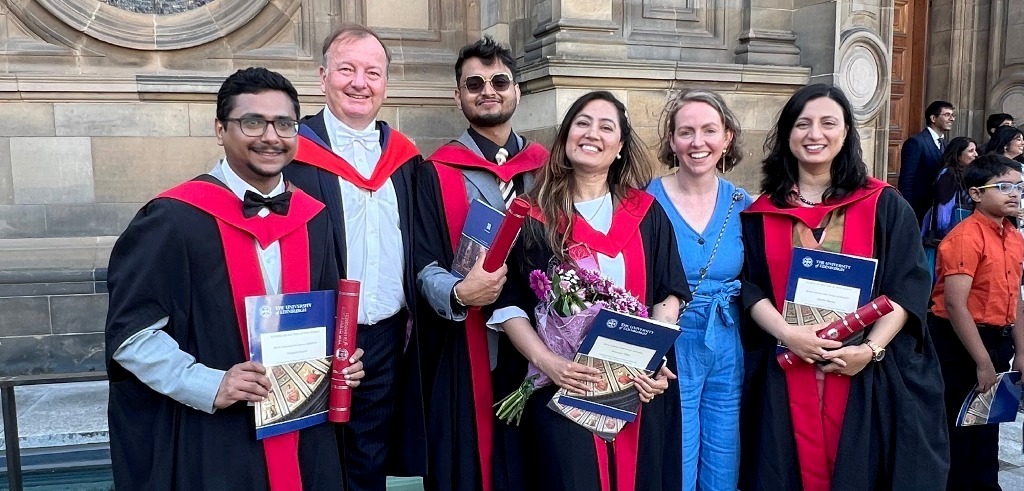
- Close
06/07/2023 | Global
How Tomorrow’s Cities is empowering communities using Future Visioning.

Future Visioning activities in Nablus – Palestine.
Since its establishment, the Tomorrow’s Cities Hub has been actively engaged in four rapidly growing mega cities of the Global South: Istanbul, Kathmandu, Nairobi, and Quito. The Hub’s primary focus has been on the development and implementation of its innovative disaster risk reduction framework, the Tomorrow’s Cities Decision Support Environment. Unlike conventional risk models, this framework takes a collaborative approach, actively involving local stakeholders in the co-production of knowledge and the formulation of risk-informed decision-making. Using a collaborative approach, the TCDSE gives voice not only to the planning authorities, municipalities, the government and the private sector, but also to the communities who will live in the future cities where the Hub is conducting its work.
The TCDSE workflow consists of five phases tailored to fit the city context. The first, Future Visioning is a co-production process whereby stakeholders come together to collectively imagine, discuss, and propose visions for the future of their city. During this stage community, municipal, national, and private sector stakeholders discuss their different priorities, struggles and, most importantly, aspirations for the future. After formulating their visions, the participants of Tomorrow’s Cities Hub actively translate these aspirations into concrete spatial plans for their respective cities and identify key policies and measures that are essential for effectively implementing their proposals and enhancing their effectiveness in mitigating risks.

The TCDSE Framework.
But what exactly is Normative Future Visioning – the formal name of this process – and why is it important for city resilience and development? Tomorrow’s Cities researchers led by Professor Mark Pelling and Dr. Thaísa Comelli just published a paper in the Climate and Development Journal that delves into the process, arguing that normative future visioning in adaptation planning – the process of evaluating vulnerabilities and prioritizing approaches to manage or minimize the impacts of climate change within an area – is important but currently not given enough attention. Professor Mark Pelling and Dr. Thaísa Comelli explain the research and how Tomorrow’s Cities is working to improve resilience in cities around the world.
TC: In your paper you argue that normative future visioning is currently an underdeveloped component of adaptation planning. Can you explain what normative future visioning is and what it can bring to the process of urban climate change adaptation or risk reduction?
Mark Pelling (MP): Normative future visioning is a way of planning for the future by involving different people and hearing their perspectives. It helps us imagine different scenarios and find new ways to solve problems and adapt to challenges. By including community and city actors in the urban planning process, alternative narratives of development can emerge, that can stimulate alternative plans and actions for development to address the underlying causes of vulnerability and risk. It’s a way of connecting what we want for the future with what we have in the present.
For instance, instead of just predicting what might happen using numerical demographic or flood hazard projections that tends to maintain the status quo, normative future visioning encourages us to think critically about choices and take action to make positive changes, especially when it comes to adapting to climate change. However, even though it has a lot of potential, not many people are using normative future visioning in their planning, it’s often forgotten or ignored when trying to make improvements that are meant to be inclusive and transparent.

Professor Mark Pelling addressing Tomorrow’s Cities Hub members at an all-hub meeting in April.
TC: Research was conducted in the four cities that firstly implemented the TCDSE. Can you help us understand the context?
MP: In each of the four learning cities, we have identified challenges in urban growth that exacerbate disaster risk. Challenges such as governance systems with limited capacity to address the needs of the urban poor, variable levels of organization and influence of urban poor communities in policymaking, and a current multi-hazard environment worsened by both planned and unplanned urban growth, which in these cities is occurring at a very high pace.
TC: That’s the context that Tomorrow’s Cities has been encountering in many of the cities…
MP: It is indeed, and our goal is to catalyse a transition from crisis management to multi-hazard risk-informed planning and decision-making. So instead of focusing only on short-term issues, we want to shift our attention to the deeper factors that limit our ability to effectively manage risks.
This research marked the first cross-city study undertaken in Tomorrow’s Cities, enabling the participation of city, national, and community stakeholders. It gave the city actors a chance to evaluate the existing conditions that promote inclusive and resilient development. Together, we looked at how the situations and changes in each city either helped or hindered efforts to make progress in achieving goals that benefit the less fortunate and prioritize safety. We examined the factors that either supported or obstructed positive changes in their respective cities.
TC: How can diverse viewpoints and aspirations from multiple city actors be effectively captured and understood?
Thaísa Comelli (TC): Our approach was based on workshops. We started by identifying stakeholders and selecting participants in collaboration with local universities and research centres. To ensure consistency and achieve the project’s goal of bridging gaps between urban planners, risk management, and public/civil society organizations, participants were primarily from municipal governments, with representation from lower-level governments and national line ministries. Civil society groups representing the urban poor and private sector interests were also included, along with a small number of independent experts and journalists to encourage diverse perspectives. The final selection of participants was based on the governance context of each city.
Within the workshops we spent a lot of time – perhaps half the complete time of the workshop – arriving at a common view of the overarching development trend for the city. This had to be something big, that encompassed culture, governance, economy and politics in the city and avoided entrenched arguments such as land rights or corruption. In all cases the discussion landed on the balance between public or collective and private or individualised responsibility for development. Once this was complete respondents found it quite easy to consider the conditions under which different development would lead to more or less resilient futures.
The “Wheel of Assets” used by researchers to capture the visions of different stakeholder groups during Future Visioning Workshops in Rapti, Nepal.
TC: I’m sure there were challenges…
TC: Yes, the greatest methodological challenge was to respect diversity in views while moving towards collective assessment. To address this, we encouraged participants to focus on overall development trajectories rather than specific projects or policies. This helped maintain a broader perspective. Secondly, anonymized individual voting was used to gather opinions on past and present city situations. Anonymity ensured unbiased responses and enabled participants to express their views freely.
TC: You then combined the data obtained from the TCDSE workshops in Istanbul, Kathmandu, Nairobi and Quito with additional work from London, Kolkata, New York and Lagos and propose a City Resilience Challenge Index. What is this index and what can it tell us about how cities are evolving?
MP: We wanted to develop and test an explorative yet comparable index for tracking the degree of challenge faced by cities in meeting their own resilience-development goals. Combining both sets of case studies generates a cohort of eight capital cities with which to test the utility of the method as a global assessment tool and responds to the IPCC 6th Assessment Report framing of resilience as an emergent property of cities
What the City Resilience Challenge Index does is to tell policymakers whether and how cities are currently moving away from, rather than towards, envisioned trajectories of vulnerability reduction and adaptation. Ranging between 0 and 1, larger values indicate a more challenging pathway choices for city actors. It also allows negative values to be assigned when the desired future and movement of development are in opposition. Positive values indicate alignment.
TC: How does the CRCI differs from other indexes?
MP: Unlike other indices that measure vulnerability or resilience in an absolute manner, this index relies on the knowledge and opinions of experts. It takes into account what people think the city should be like in terms of development and resilience. This index allows us to look at how far the city is from reaching its goals and what needs to be done to bridge that gap. It helps us keep track of progress over time and make sure the city is on the right path to becoming more resilient.

Development trajectories of eight cities used in the research.
TC: And how did Tomorrow’s Cities four learning cities perform in the City Resilience Challenge Index?
TC: All four cities recognised a need for increased effort and investment in reducing risk. They acknowledged the need for future cities to be more aware of natural hazard risk and plan in accordingly to minimize them. This involves implementing technical strategies of land-use planning, building design and local regulations. In addition, three cities – Istanbul, Quito and Kathmandu – wanted to accelerate existing trends in government reform,to create a more favourable environment for successful technological investments. In Quito and Kathmandu, recent experiences with large scale urban earthquakes and subsequent policy reform were seen as helpful and to have oriented development policy well for future risk reduction. The picture in Nairobi was more complicated. Participants aimed to redirect political and developmental changes by establishing a stronger state that upholds the rule of law and enacts urban planning. At the same time they also emphasized the importance of giving a greater voice to the private sector and organized groups of urban poor in urban planning processes to reduce risk.
TC: What are the main conclusions from this study?
MP: The study found that inclusive methods, like Normative Future Visioning, work well in dealing with reducing risks from multiple hazards, and meeting development needs. These methods challenge the way urban development is made and promote inclusive change. By testing the methods in Nairobi, Quito, Istanbul, and Kathmandu, we were able to successfully identify the main causes of risks and assess how well cities are prepared to adapt to challenges.
All cities unanimously acknowledge the importance of creating supportive enabling environments – such as those that we create during the workshops – that foster inclusive technical interventions. Some cities are also aware that the current context is limiting the possibility to implement changes leading to inclusive resilience.
These findings are consistent with a broader range of cities beyond the ones involved in Tomorrow’s Cities program, indicating the validity and transferability of the program’s approach in fostering political, policy, and technical learning and action.
In its turn, The City Resilient Challenge (CRC) Index enabled us to track the performance of cities in bridging the gap between the conditions needed to adapt to challenges and reduce risks, and the conditions that currently exist. This index can be used on a global scale.
Both inclusive NFV and the CRC Index shift our attention from the past to the future, allowing us to take action based on the difference between how things are now and how we want them to be.


Future Visions in Rapti, Nepal.
TC: What is the way forward?
MP: Having established the importance of NFV in transformative processes two immediate priorities are to embed NFV into Tomorrow’s Cities methodologies, which is what we’ve been doing in the Future Visioning stage of the TCDSE; and connecting NFV to policy action – the interface between Future Visioning and the following stage Visioning Scenario Development and the mission of the Risk Agreement and Visioning Scenario Assessment stages.
These steps are crucial for advancing our methodology and sharing lessons learned, ultimately translating visioning into tangible action.


